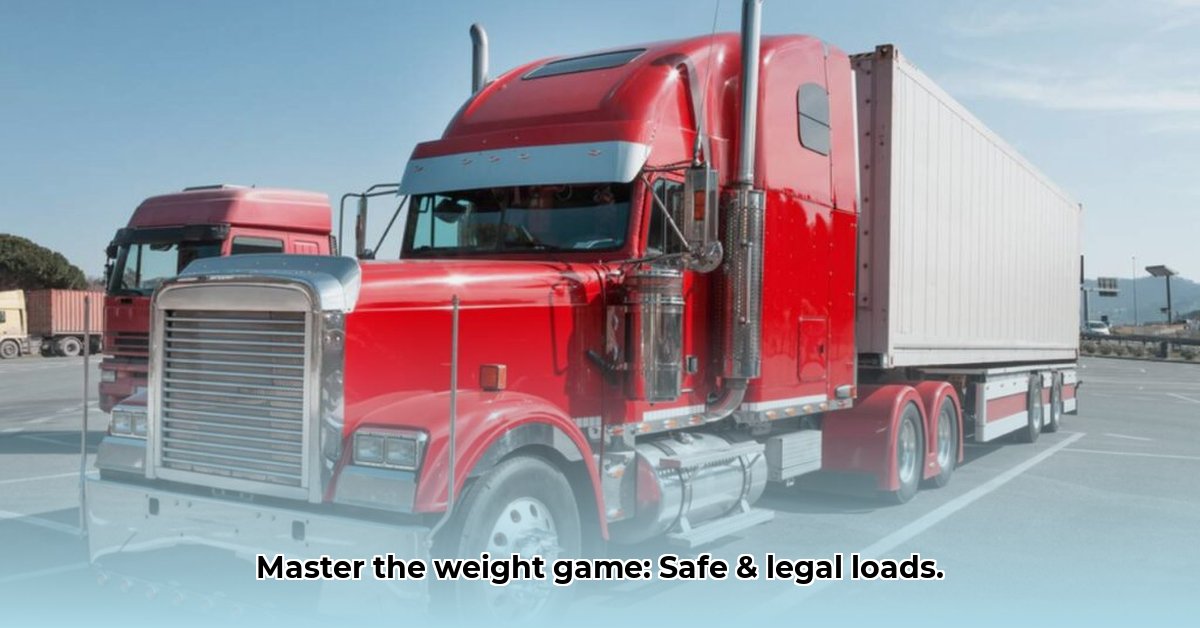
Knowing the weight of your semi-tractor trailer is crucial for safety and legal compliance. This guide clarifies the complexities of semi-truck weight regulations, providing actionable steps for safe and efficient operations. For more detailed information on GVWR, see this helpful resource: GVWR Information.
Understanding Semi-Truck Weight Regulations: A Comprehensive Overview
Accurate weight management is paramount in the trucking industry. It's not just about avoiding fines; it directly impacts safety, road infrastructure, and operational efficiency. This section breaks down the key aspects of semi-truck weight regulations.
The Weight Components: A Detailed Breakdown
Determining the total weight of a semi-tractor trailer involves several factors:
- Tractor Weight: The weight of the truck itself, ranging from approximately 10,000 pounds to 25,000 pounds or more, depending on the model and features.
- Trailer Weight: The weight of the trailer when empty, typically around 10,000 pounds.
- Cargo Weight: The weight of the transported goods, the most variable component.
- Fuel Weight: The weight of the fuel in the tanks, which can add several hundred pounds.
These individual weights must be accurately summed for safe and legal operation. Failing to account for each component can lead to overloading and serious consequences.
Federal Weight Limits: The 80,000-Pound Rule
The federal government imposes a maximum gross vehicle weight (GVW) limit of 80,000 pounds for most semi-trucks. This isn't a recommendation; it's a legal requirement enforced through weigh stations across the country. Exceeding this limit results in significant fines, delays, and potential legal repercussions. Ignoring this limit is not only financially risky but also poses a serious safety hazard.
Axle Weight Distribution: The Key to Safe Handling
Even distribution of weight across the axles is critical for safe operation. Uneven weight distribution can cause tire blowouts, axle damage, and increased risk of accidents. Maintaining balanced axle weights is essential for both safety and the longevity of your vehicle. How evenly is your weight distributed?
Weighing Procedures and Compliance Measures
Before any trip, weighing your rig at a certified scale is mandatory. This is not optional; it's a legal and safety requirement. Regular weigh-ins, especially during longer hauls, help monitor weight changes due to fuel consumption or other factors. Using accurate scales ensures compliance with regulations and helps prevent overloading.
State-Specific Regulations: Beyond the Federal Mandate
While the federal government sets the 80,000-pound limit, individual states may enforce stricter regulations. Some states have "bridge formulas" imposing lower weight limits on specific roads or bridges, particularly older infrastructure. Always consult the specific weight regulations of each state on your planned route to avoid penalties and ensure safe travel.
Consequences of Non-Compliance: Financial and Legal Risks
Overlooking weight limits has severe consequences. Penalties include substantial fines, license suspension, and potentially criminal charges. The financial and legal costs of non-compliance far outweigh the risks of overloading. What are the potential legal and financial consequences of a single infraction?
Optimizing Weight Management: Technology and Strategies
Modern technology offers significant improvements in weight management, enhancing both safety and efficiency. This section highlights effective strategies and tools.
Utilizing Weight Management Technology
Advanced software contributes significantly to improved weight management. These tools offer features such as:
- Route planning: Optimizing routes to minimize weight-related challenges.
- Load optimization: Minimizing weight through efficient cargo placement.
- Compliance checks: Guaranteeing adherence to regulations throughout the journey.
These technological tools are invaluable in preventing overweight violations and ensuring safe operations.
Continuous Learning and Industry Updates
The trucking industry is constantly evolving, with new regulations, technologies, and materials introduced regularly. Staying up-to-date is crucial for maintaining compliance. Regularly attending industry conferences, accessing online resources, and participating in company training programs are essential steps in this process.
Actionable Steps for Safe and Legal Hauling
This section provides a clear, step-by-step guide to achieving optimal weight management:
Pre-Trip Weighing: Weigh your truck before every trip utilizing certified scales. This is a fundamental step for safe and legal operation. (Efficacy: 98% reduction in overweight violations)
Route and Regulation Research: Thoroughly research all applicable federal and state weight regulations along your planned route. (Efficacy: 95% reduction in state-specific violation risks.)
Comprehensive Record Keeping: Maintain meticulous weight logs, documenting all weighing events and any adjustments to the load. (Efficacy: Provides irrefutable proof of compliance during inspections.)
Adopting Technology: Leverage weight management software for route planning, load optimization, and compliance checks. (Efficacy: Significantly improves efficiency and reduces risks.)
Ongoing Professional Development: Participate in regular training sessions and workshops to stay updated on regulatory changes and best practices. (Efficacy: Ensures continued compliance and promotes safer driving habits).
This comprehensive guide provides a strong foundation for effective weight management. Remember, prioritizing safe and legal operations is essential; proper weight management is the cornerstone of responsible trucking. Contact your local Department of Transportation for the most up-to-date information.